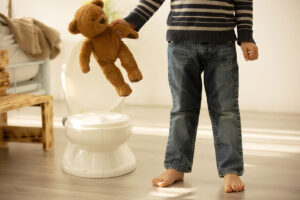Helping a Child with Bedwetting and Other Toileting Problems
Even after a child has learned successful daytime potty skills, they may experience other toileting challenges. For example, overnight bedwetting or pooping in their pants is not uncommon for kids who were exposed to substances before birth or who are coping with trauma. Hang in there – you’re not alone in the frustration of these toileting problems. This guide will help you understand and handle these challenges with care and patience.
What Is Bedwetting?
 Bedwetting (also called nocturnal enuresis) means a child still urinates during sleep, even after they’ve learned to use the bathroom during the day. It’s normal and about 15% of 5-year-olds wet the bed. Your grandchild’s early life experiences (like prenatal substance exposure or neglect) may mean they will take longer to stay dry through the night.
Bedwetting (also called nocturnal enuresis) means a child still urinates during sleep, even after they’ve learned to use the bathroom during the day. It’s normal and about 15% of 5-year-olds wet the bed. Your grandchild’s early life experiences (like prenatal substance exposure or neglect) may mean they will take longer to stay dry through the night.
Why It Happens
Kids with prenatal exposure might need extra time to learn bladder control. That’s okay—every child learns differently. Some reasons that bedwetting happens include:
- Bladder control issues – Their bladder may not hold enough urine overnight.
- Brain-to-bladder delays – Their brain may not fully learn to react when the bladder fills while they’re asleep.
- Deep sleepers – They don’t wake even when their bladder is full.
- Stress or trauma – These can affect sleep and body control, making accidents more likely.
How You Can Help
These tips can help you help your grandchild cope with the experiences of nighttime bedwetting or poop accidents.
1. Talk with their doctor(s).
Ask their pediatrician to check for medical or emotional causes. Some kids might need a physical or help to cope with their stress, sleep problems, or bladder control.
2. Use easy-to-change bedding.
Keep spare bedding, such as waterproof sheets and extra pajamas, in their room. Letting this child help change things can build pride and independence. Be matter-of-fact and patient while they learn how to handle this process.
3. Set a consistent bedtime bathroom routine.
Ask your grandchild to use the toilet right before bed. A full bladder at bedtime makes accidents more likely.
4. Limit liquids at night
Offer water or milk at dinner, and then gently restrict drinks (including things like popsicles) about one to two hours before sleep to help them stay dry.
5. Use night lights.
Many kids are afraid of the dark. This child may have more than typical reasons to fear the dark, based on previous experiences and environments where they lived. Keep a light in the hallway or bathroom to reassure them that they are safe to get up if they need to pee during the night.
6. Praise them for nights without accidents.
Celebrate dry nights with positive words, hugs, or a fun sticker. Avoid making a big deal out of wet nights by saying “That’s okay—a dry night is coming!”
7. Try to avoid extra pressure.
- Don’t punish or shame them for wetting the bed.
- Don’t force them to wake up at night to pee. This can be confusing and doesn’t always help.
- Don’t remind them to pee repeatedly, especially in front of other people. They might feel embarrassed or anxious and this will only increase that anxiety.
Other Toileting Challenges
Though nighttime bedwetting is the most common toileting struggle kids face, there may be other challenges that crop up.
- Constipation — hard, painful stools can make it harder to control pooping
- Holding pee or poop too long. Some kids worry about when or where they will need to pee or poop and wait too long. This increases the risk of accidents.
- Stalling or ignoring their body’s signals because they are engrossed in an activity that is hard to leave.
What You Can Do
To help them stay on track with regular bowel movements and respect their body’s signals, try some of these practical supports:
- Offer fiber-rich foods, fruits, and plenty of water to prevent constipation.
- Watch them for signs like crossing legs, grimacing, or hiding to hold in pee/poop. Create a signal that you can use to quietly alert them to pay attention to their body.
- Keep their potty routines regular, simple, and predictable.
- Use visual cues—for example, a chart or sign that shows the steps to “potty time.”
Teaching Calm and Comfort
No matter this child’s toileting issue—nighttime bedwetting, constipation, or daytime accidents—the most important thing is to stay calm, patient, and kind. These challenges can make a child feel ashamed and embarrassed. When you stay calm, you help them feel safe. When you normalize that potty issues are a set of skills they can learn, no matter how much they struggle, they will learn faster.
However, remember that toileting skills may take this child months or even a year to fully master. That’s okay. Again, maintain simple, consistent routines. Focus on successes no matter how small. And be present for this child with lots of encouragement.
Remember, too, that you are teaching more than toileting skills. You are teaching your grandchild they are safe, cared for, and believed in, no matter what challenges they face. Through their bedwetting or bathroom accidents, they can learn you are there, steady and gentle. By staying patient and kind as they learn, you help heal their hearts, minds, and spirits. This journey—slow, steady, and love-filled—leads your child to confidence, independence, and hope.
Additional resources to consider:
